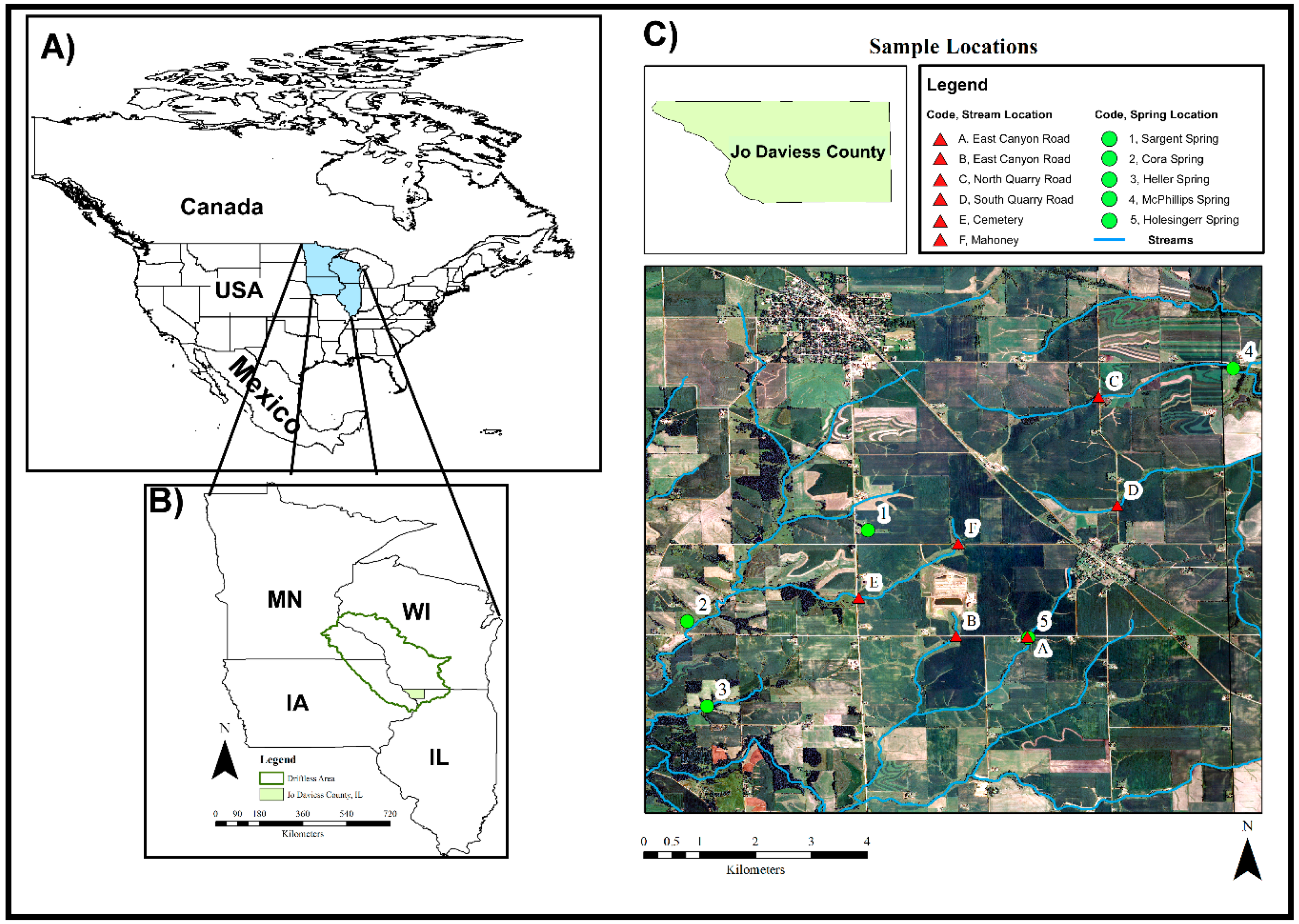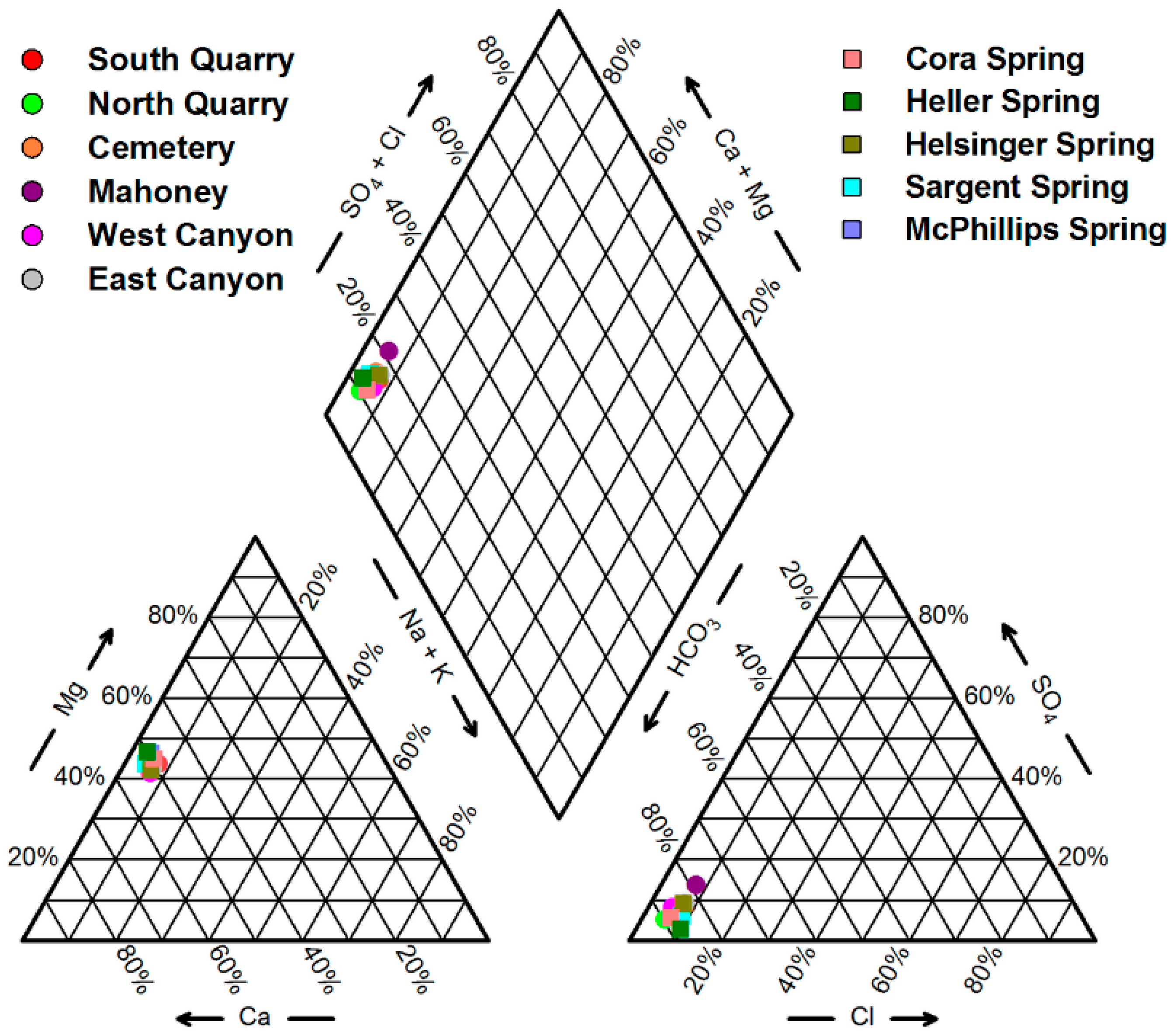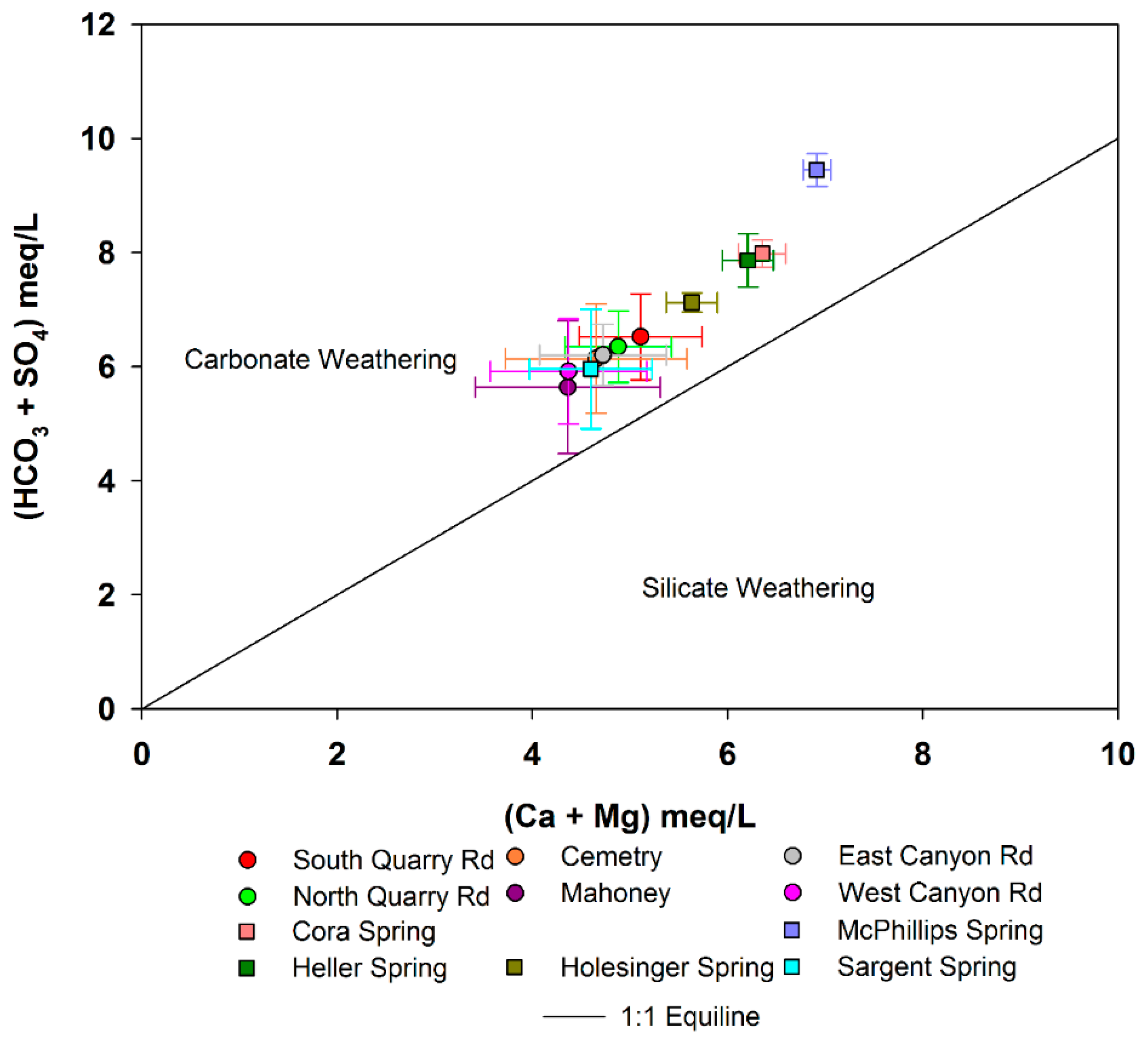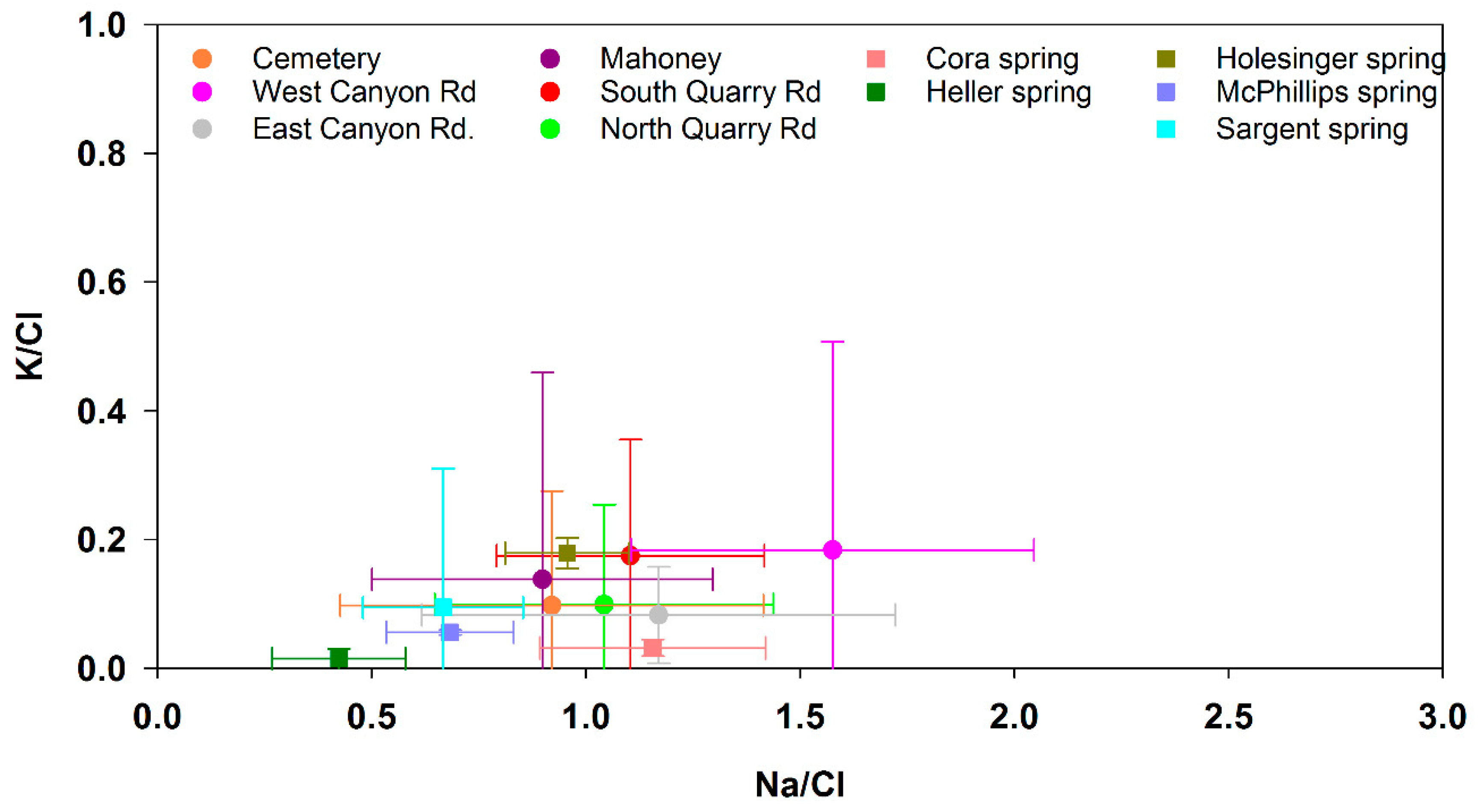Differentiation of Surface Water and Groundwater in a Karst System Using Anthropogenic Signatures
Abstract
:1. Introduction
2. Materials and Methods
2.1. Geologic Setting
2.2. Methods
2.3. Statistical Analyses
3. Results
3.1. Field Parameters
3.2. Anions
3.3. Cations
3.4. Saturation Indices (SI)
3.5. Statistical Analysis
4. Discussion
4.1. Comparison: Stream and Spring Water Chemistry
4.2. Anthropogenic Influences
5. Conclusions
Supplementary Materials
Author Contributions
Funding
Acknowledgments
Conflicts of Interest
References
- Gillieson, D.S. Caves: Processes, Development, and Management; Blackwell Publishers: Oxford, UK, 1996; p. 324. [Google Scholar]
- Green, R.T.; Painter, S.L.; Sun, A.; Worthington, S.R.H. Groundwater Contamination in Karst Terranes. Waterairsoil Pollut. Focus 2006, 6, 157–170. [Google Scholar] [CrossRef]
- Palmer, A.N. Cave Geology; Cave Books: Dayton, OH, USA, 2007. [Google Scholar]
- Gupta, S.; Munyankusi, E.; Moncrief, J.; Zvomuya, F.; Hanewall, M. Tillage and manure application effects on mineral nitrogen leaching from seasonally frozen soils. J. Environ. Qual. 2004, 33, 1238–1246. [Google Scholar] [CrossRef]
- Angel, J.C.; Peterson, E.W. Nitrates in karst systems: Comparing impacted systems to a relatively unimpacted system. J. Geogr. Geol. 2015, 7, 65–76. [Google Scholar] [CrossRef]
- Panno, S.V.; Kelly, W.R. Nitrate and herbicide loading in two groundwater basins of Illinois’ sinkhole plain. J. Hydrol. 2004, 290, 229–242. [Google Scholar] [CrossRef]
- Peterson, E.; Davis, R.; Brahana, J.; Orndorff, H. Movement of nitrate through regolith covered karst terrane, northwest Arkansas. J. Hydrol. 2002, 256, 35–47. [Google Scholar] [CrossRef]
- Kresic, N.; Papic, P.; Golubovic, R. Elements of groundwater protection in a karst environment. Environ. Geol. Water Sci. 1992, 20, 157–164. [Google Scholar] [CrossRef]
- Long, A.J.; Sawyer, J.F.; Putnam, L.D. Environmental tracers as indicators of karst conduits in groundwater in South Dakota, USA. Hydrogeol. J. 2008, 16, 263–280. [Google Scholar] [CrossRef]
- Mooers, H.D.; Alexander, E.C., Jr. Contribution of spray irrigation of wastewater to groundwater contamination in the karst of southeastern Minnesota, USA. Appl. Hydrogeol. 1994, 2, 34–44. [Google Scholar] [CrossRef]
- Nguyet, V.T.M.; Goldscheider, N. Tracer tests, hydrochemical and microbiological investigations as a basis for groundwater protection in a remote tropical mountainous karst area, Vietnam. Hydrogeol. J. 2006, 14, 1147–1159. [Google Scholar] [CrossRef] [Green Version]
- Hackley, K.C.; Panno, S.V.; Hwang, H.H.; Kelly, W.R. Groundwater Quality of Springs and Wells of the Sinkhole Plain in Southwestern Illinois; Illinois State Geological Survey: Champaign, IL, USA, 2007; Volume 570, p. 39. [Google Scholar]
- Crain, A.S. Pesticides and Nutrients in Karst Springs in the Green River basin, Kentucky, May–September 2001; 133-01; United States Geological Survey: Louisville, KY, USA, 2002; p. 3.
- Taraba, J.; Dinger, J.; Sendlein, L.; Felton, G. Land use impacts on water quality in small karst agricultural watersheds. In Proceedings of the Karst-Water Environment Symposium, Roanoke, VR, USA, 30–31 October 1997; p. 127. [Google Scholar]
- Robinson, H.K.; Hasenmueller, E.A.; Chambers, L.G. Soil as a reservoir for road salt retention leading to its gradual release to groundwater. Appl. Geochem. 2017, 83, 72–85. [Google Scholar] [CrossRef]
- Dodgen, L.K.; Kelly, W.R.; Panno, S.V.; Taylor, S.J.; Armstrong, D.L.; Wiles, K.N.; Zhang, Y.; Zheng, W. Characterizing pharmaceutical, personal care product, and hormone contamination in a karst aquifer of southwestern Illinois, USA, using water quality and stream flow parameters. Sci. Total Environ. 2017, 578, 281–289. [Google Scholar] [CrossRef] [PubMed]
- Kelly, W.R.; Panno, S.V.; Hackley, K.C.; Martinsek, A.T.; Krapac, I.G.; Weibel, C.P.; Storment, E.C. Bacteria Contamination of Groundwater in a Mixed Land-Use Karst Region. Water Qual. Expo. Health 2009, 1, 69–78. [Google Scholar] [CrossRef]
- Katz, B.G.; Griffin, D.W. Using chemical and microbiological indicators to track the impacts from the land application of treated municipal wastewater and other sources on groundwater quality in a karstic springs basin. Environ. Geol. 2008, 55, 801–821. [Google Scholar] [CrossRef]
- Mahler, B.J.; Personne, J.C.; Lods, G.F.; Drogue, C. Transport of free and particulate-associated bacteria in karst. J. Hydrol. 2000, 238, 179–193. [Google Scholar] [CrossRef]
- Maticic, B. The impact of agriculture on ground water quality in Slovenia: Standards and strategy. Agric. Water Manag. 1999, 40, 235–247. [Google Scholar] [CrossRef]
- Liu, A.; Ming, J.; Ankumah, R.O. Nitrate contamination in private wells in rural Alabama, United States. Sci. Total Environ. 2005, 346, 112–120. [Google Scholar] [CrossRef] [PubMed]
- Boyer, D.G.; Pasquarell, G.C. Nitrate concentrations in karst springs in an extensively grazed area. Water Resour. Bull. 1995, 31, 729–736. [Google Scholar] [CrossRef]
- United States Environmental Protection Agency. 2011 Edition of the Drinking Water Standards and Health Advisories; U.S. Environmental Protection Agency: Washington, DC, USA, 2011; p. 18.
- Hem, J.D. Study and Interpretation of the Chemical Characteristics of Natural Water; 1473; U.S. Department of the Interior; U.S. Geological Survey: Washington, DC, USA, 1959.
- Link, M.L.; Inman, D.L. Ground Water Monitoring at Livestock Waste Control Facilities in NEBRASKA; Ground Water Unit, Water Quality Assessment Section, Nebraska Department of Environmental Quality: Lincoln, NE, USA, 2003.
- Panno, S.V.; Hackley, K.C.; Hwang, H.H.; Greenberg, S.E.; Krapac, I.G.; Landsberger, S.; O’Kelly, D.J. Characterization and identification of Na-Cl sources in ground water. Ground Water 2006, 44, 176–187. [Google Scholar] [CrossRef]
- Kelly, W.R. Long-term trends in chloride concentrations in shallow aquifers near Chicago. Ground Water 2008, 46, 772–781. [Google Scholar] [CrossRef]
- Quade, D.; Libra, R.; Seigley, L.; Bettis, E. Groundwater monitoring at an earthen manure-storage structure. Iowa Dep. Nat. Resour. Hogsbogslogs Quat. Depos. Environ. Geol. Des Moines Lobe Geol. Surv. Bur. Guideb. Ser. 1996, 18, 141–153. [Google Scholar]
- Davis, R.K.; Hamilton, S.; Brahana, J.V. Escherichia coli survival in mantled karst springs and streams, northwest Arkansas Ozarks, USA. J. Am. Water Resour. Assoc. 2005, 41, 1279–1287. [Google Scholar] [CrossRef]
- Peterson, E.; Davis, R.; Orndorff, H. 17b-estradiol as an indicator of animal waste contamination in mantled karst aquifers. J. Environ. Qual. 2000, 29, 826–834. [Google Scholar] [CrossRef]
- Ting, T.E.; Davis, R.K.; Brahana, J.V.; Hays, P.D.; Thoma, G. Application of Multiple Tracers to Characterize Complex Sediment and Pathogen Transport in Karst. In Proceedings of the U.S. Geological Survey Karst Interest Group Proceedings, Rapid City, SD, USA, 12–15 September 2005; p. 114. [Google Scholar]
- Howell, J.M.; Coyne, M.S.; Cornelius, P. Fecal Bacteria in Agricultural Waters of the Bluegrass Region of Kentucky. J. Environ. Qual. 1995, 24, 411–419. [Google Scholar] [CrossRef]
- Massei, N.; Lacroix, M.; Wang, H.Q.; Dupont, J.P. Transport of particulate material and dissolved tracer in a highly permeable porous medium: Comparison of the transfer parameters. J. Contam. Hydrol. 2002, 57, 21–39. [Google Scholar] [CrossRef]
- Stoddard, C.S.; Coyne, M.S.; Grove, J.H. Fecal bacteria survival and infiltration through a shallow agricultural soil: Timing and tillage effects. J. Environ. Qual. 1998, 27, 1516–1523. [Google Scholar] [CrossRef]
- Griffioen, J. Potassium adsorption ratios as an indicator for the fate of agricultural potassium in groundwater. J. Hydrol. 2001, 254, 244–254. [Google Scholar] [CrossRef]
- Bottrell, S.; Tellam, J.; Bartlett, R.; Hughes, A. Isotopic composition of sulfate as a tracer of natural and anthropogenic influences on groundwater geochemistry in an urban sandstone aquifer, Birmingham, UK. Appl. Geochem. 2008, 23, 2382–2394. [Google Scholar] [CrossRef]
- Einsiedl, F.; Mayer, B. Hydrodynamic and Microbial Processes Controlling Nitrate in a Fissured-Porous Karst Aquifer of the Franconian Alb, Southern Germany. Environ. Sci. Technol. 2006, 40, 6697–6702. [Google Scholar] [CrossRef]
- Panno, S.V.; Luman, D.E. Assessment of the Geology and Hydrogeology of Two Sites for a Proposed Large Dairy Facility in Jo Daviess County Near Nora, IL; Illinois State Geological Survey, Institute of Natural Resource Sustainability, University of Illinois: Champaign, IL, USA, 2008. [Google Scholar]
- Bray, R.H. Soil-plant relations: I. The quantitative relation of exchangeable potassium to crop yields and to crop response to potash additions. Soil Sci. 1944, 58, 305–324. [Google Scholar] [CrossRef]
- Panno, S.V.; Luman, D.E.; Kolata, D.R. Characterization of Karst Terrain and Regional Tectonics Using Remotely Sensed Data in Jo Daviess County, Illinois; Illinois State Geological Survey: Champaign, IL, USA, 2015; p. 29. [Google Scholar]
- Stiles, C.A.; Stensvold, K.A. Loess contribution to soils forming on dolostone in the Driftless Area of Wisconsin. Soil Sci. Soc. Am. J. 2008, 72, 650–659. [Google Scholar] [CrossRef]
- Schneider, J.; Nikodem, L.; Rumpler, J. Factory Farms, Fouled Waters: How Industrial Livestock Operations Pollute Illinois Rivers, Lakes and Streams; Environment Illinois Research & Education Center: Chicago, IL, USA, 2014; p. 29. [Google Scholar]
- Willman, H.B.; Kolata, D.R. The Platteville and Galena Groups in Northern Illinois; Illinois State Geological Survey: Urbana, IL, USA, 1978; p. 75. [Google Scholar]
- Maas, B.; Peterson, E.W.; Malone, D.; Nelson, R. Surficial Geology of the Warren 7.5 Minute Quadrangle, JoDaviess and Stephenson Counties, Illinois. In EDMAP; Illinois State Geological Survey: Champaign, IL, USA, 2010. [Google Scholar]
- Lax, S.M.; Peterson, E.W.; Van der Hoven, S. Quantifying Stream chloride concentrations as a function of land-use. Environ. Earth Sci. 2017, 76, 12. [Google Scholar] [CrossRef]
- McGarry, C.S. Bedrock Geology of Boone and Winnebago Counties, Illinois; Illinois State Geological Survey: Champaign, IL, USA, 2000. [Google Scholar]
- Tegeler, R.A. Soil Survey of Jo Daviess County, Illinois; United States Department of Agriculture: Buckeye, AZ, USA, 1996; p. 224.
- Homer, C.H.; Fry, J.A.; Barnes, C.A. The National Land Cover Database; United States Geological Survey: Reston, VR, USA, 2012.
- White, W.B. Geomorphology and Hydrology of Karst Terrains; Oxford University Press: New York, NY, USA, 1988; p. 464. [Google Scholar]
- Parkhurst, D.L.; Appelo, C. User’s guide to PHREEQC (version 2)–a computer program for speciation, batch-reaction, one-dimensional transport, and inverse geochemical calculations. Water-Resour. Investig. Rep. 1999, 99, 312. [Google Scholar]
- American Public Health Association. 5210 B. 5-Day BOD Test. In Standard Methods for the Examination of Water and Wastewater, 21st ed.; American Public Health Association: Washington, DC, USA, 2005; p. 1368. [Google Scholar]
- Water Environmental Federation; American Public Health Association. Standard Methods for the Examination of Water and Wastewater; American Public Health Association: Washington, DC, USA, 2005; Volume 1015, pp. 49–51. [Google Scholar]
- Gibbs, R.J. Mechanisms Controlling World Water Chemistry. Science 1970, 170, 1088–1090. [Google Scholar] [CrossRef] [PubMed]
- Doucette, R.; Peterson, E.W. Identifying water sources in a karst aquifer using thermal signatures. Environ. Earth Sci. 2014, 72, 5171–5182. [Google Scholar] [CrossRef]
- Luhmann, A.J.; Covington, M.D.; Peters, A.J.; Alexander, S.C.; Anger, C.T.; Green, J.A.; Runkel, A.C.; Alexander, E.C., Jr. Classification of Thermal Patterns at Karst Springs and Cave Streams. Ground Water 2010, 49. [Google Scholar] [CrossRef] [PubMed]
- Datta, P.; Tyagi, S. Major ion chemistry of groundwater in Delhi area: Chemical weathering processes and groundwater flow regime. J. Geol. Soc. India 1996, 47, 179–188. [Google Scholar]
- Lakshmanan, E.; Kannan, R.; Kumar, M.S. Major ion chemistry and identification of hydrogeochemical processes of ground water in a part of Kancheepuram district, Tamil Nadu, India. Environ. Geosci. 2003, 10, 157–166. [Google Scholar] [CrossRef]
- Lax, S.; Peterson, E.W. Characterization of chloride transport in the unsaturated zone near salted road. Environ. Geol. 2009, 58, 1041–1049. [Google Scholar] [CrossRef]
- Taylor, S.J.; Kelly, W.R.; Panno, S.V.; Weck, R.; Zheng, W.; Zhang, Y.; Liu, W.-T. Karst Groundwater Contaminants in Western Illinois: Comparison of Current Conditions with Historical data; Illinois Natural History Survey, Prairie Research Institute, University of Illinois: Champaign, IL, USA, 2014; p. 53. [Google Scholar]
- Geldreich, E.E. Microbial Quality of Water Supply in Distribution Systems; CRC Press: Boca Raton, FL, USA, 1996. [Google Scholar]
- Janardhana Raju, N.; Shukla, U.K.; Ram, P. Hydrogeochemistry for the assessment of groundwater quality in Varanasi: A fast-urbanizing center in Uttar Pradesh, India. Environ. Monit. Assess. 2011, 173, 279–300. [Google Scholar] [CrossRef]
- Yuan, J.; Xu, F.; Deng, G.; Tang, Y.; Li, P. Hydrogeochemistry of Shallow Groundwater in a Karst Aquifer System of Bijie City, Guizhou Province. Water 2017, 9, 625. [Google Scholar] [CrossRef]
- Musgrove, M.; Opsahl, S.P.; Mahler, B.J.; Herrington, C.; Sample, T.L.; Banta, J.R. Source, variability, and transformation of nitrate in a regional karst aquifer: Edwards aquifer, central Texas. Sci. Total Environ. 2016, 568, 457–469. [Google Scholar] [CrossRef] [Green Version]
- Peterson, E.W.; Davis, R.K.; Brahana, J.V. The use of regression analysis to predict nitrate-nitrogen concentrations in springs of Northwest Arkansas. In Groundwater Flow and Contaminant Transport in Carbonate Aquifers; Sasowsky, I.D., Wicks, C.M., Eds.; A.A Balkema: Rotterdam, The Netherlands, 2000; pp. 43–63. [Google Scholar]
- Panno, S.V.; Kelly, W.R. Driftless Area Karst of Northwestern Illinois and its Effects on Groundwater Quality. In Proceedings of the 14th Multidisciplinary Conference on Sinkholes and the Engineering and Environmental Impacts of Karst, Rochester, MN, USA, 5–9 October 2015; pp. 63–74. [Google Scholar]
- Panno, S.V.; Krapac, I.G.; Weibel, C.P.; Bade, J.D. Groundwater Contamination in Karst Terrain of Southwestern Illinois; Environmental Geology Series No. 151; Illinois State Geological Survey: Champaign, IL, USA, 1996; p. 43. [Google Scholar]
- Patel, P.; Raju, N.J.; Reddy, B.C.S.R.; Suresh, U.; Gossel, W.; Wycisk, P. Geochemical processes and multivariate statistical analysis for the assessment of groundwater quality in the Swarnamukhi River basin, Andhra Pradesh, India. Environ. Earth Sci. 2016, 75, 611. [Google Scholar] [CrossRef]
- Goff, J.P. Macromineral physiology and application to the feeding of the dairy cow for prevention of milk fever and other periparturient mineral disorders. Anim. Feed Sci. Technol. 2006, 126, 237–257. [Google Scholar] [CrossRef]
- Personne, J.C.; Poty, F.; Vaute, L.; Drogue, C. Survival, transport and dissemination of Escherichia coli and enterococci in a fissured environment. Study of a flood in a karstic aquifer. J. Appl. Microbiol. 1998, 84, 431–438. [Google Scholar] [CrossRef] [PubMed]
- Panno, S.V.; Kelly, W.R.; Martinsek, A.T.; Hackley, K.C. Estimating background and threshold nitrate concentrations using probability graphs. Ground Water 2006, 44, 697–709. [Google Scholar] [CrossRef]
- Peterson, E.W.; Hayden, K.M. Transport and Fate of Nitrate in the Streambed of a Low-Gradient Stream. Hydrology 2018, 5, 55. [Google Scholar] [CrossRef]
- Duff, J.H.; Triska, F.J. Denitrification in sediments from the hyporheic zone adjacent to a small forested stream. Can. J. Fish. Aquat. Sci. 1990, 47, 1140–1147. [Google Scholar] [CrossRef]
- Follett, R.F.; Delgado, J.A. Nitrogen fate and transport in agricultural systems. J. Soil Water Conserv. 2002, 57, 402–408. [Google Scholar]
- Hinkle, S.R.; Duff, J.H.; Triska, F.J.; Laenen, A.; Gates, E.B.; Bencala, K.E.; Wentz, D.A.; Silva, S.R. Linking hyporheic flow and nitrogen cycling near the Willamette River—A large river in Oregon, USA. J. Hydrol. 2001, 244, 157–180. [Google Scholar] [CrossRef]







| Parameter | Stream | Spring | p-Value |
|---|---|---|---|
| Median | Median | ||
| pH | 7.34 | 6.51 | <0.001 |
| Temperature—°C | 11.7 | 10.8 | 0.437 |
| Dissolved Oxygen—mg/L | 9.6 | 6.6 | <0.001 |
| Biological Oxygen Demand—mg/L | 6.0 | 3.6 | <0.001 |
| Specific Conductance—S/cm | 656 | 807 | <0.001 |
| Total Coliform—CFU/100mL | 148 | 43.5 | 0.001 |
| Chloride—mg/L | 13.5 | 17.4 | <0.001 |
| Sulfate—mg/L | 21.8 | 17.6 | 0.026 |
| Bicarbonate—mg/L | 268.4 | 359.9 | <0.001 |
| Nitrate as nitrogen—mg/L | 9.3 | 12.2 | <0.001 |
| Calcium—mg/L | 68.4 | 81.7 | <0.001 |
| Magnesium—mg/L | 35.9 | 45.0 | <0.001 |
| Sodium—mg/L | 8.4 | 8.9 | 0.521 |
| Potassium—mg/L | 0.9 | 0.7 | 0.256 |
| SI—Calcite | −0.13 | −0.72 | <0.001 |
| SI—Dolomite | −0.39 | −1.60 | <0.001 |
© 2019 by the authors. Licensee MDPI, Basel, Switzerland. This article is an open access article distributed under the terms and conditions of the Creative Commons Attribution (CC BY) license (http://creativecommons.org/licenses/by/4.0/).
Share and Cite
Maas, B.; Peterson, E.W.; Honings, J.; Oberhelman, A.; Oware, P.; Rusthoven, I.; Watson, A. Differentiation of Surface Water and Groundwater in a Karst System Using Anthropogenic Signatures. Geosciences 2019, 9, 148. https://doi.org/10.3390/geosciences9040148
Maas B, Peterson EW, Honings J, Oberhelman A, Oware P, Rusthoven I, Watson A. Differentiation of Surface Water and Groundwater in a Karst System Using Anthropogenic Signatures. Geosciences. 2019; 9(4):148. https://doi.org/10.3390/geosciences9040148
Chicago/Turabian StyleMaas, Benjamin, Eric W. Peterson, Joe Honings, Andrew Oberhelman, Prince Oware, Ian Rusthoven, and Andrew Watson. 2019. "Differentiation of Surface Water and Groundwater in a Karst System Using Anthropogenic Signatures" Geosciences 9, no. 4: 148. https://doi.org/10.3390/geosciences9040148





